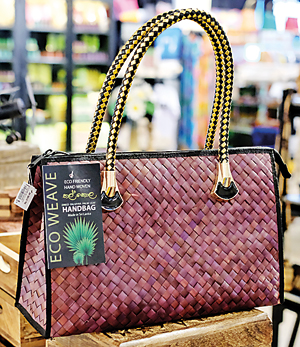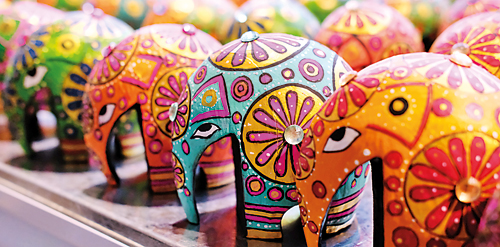Let’s us give tradition a little twist, shall we?
“We don’t have to stick to a 2000-year old tradition. That became a tradition because it was created so many years ago. Crafts need not be only traditional, they can be contemporary as well to suit this age,” says well known design expert Senaka De Silva.

Senaka De Silva: Bringing a contemporary feel
This is the thinking behind Lak Arcade, the newest player in the handicrafts market. Lak Arcade combines its motto of fusing heritage with modern trends to showcase items that appeal to shoppers of today.
Located on bustling Staples Street in Union Place, it is easy to spend a while browsing through displays at this spacious store.
Serving as their Product Development Senior Design Consultant, Senaka De Silva, with his years of experience to back him up, including his work with the National Craft Council, focuses on his strategy for preserving the sustainability of the handicrafts trade: bringing it into the new millennium.
“They [Lak Arcade] divert the craftsmen to me and I look at what they’re doing. I don’t stop it. I tell them ‘while continuing that, why don’t you try this?’ And then we see how it moves the market. We actually create markets for craftspeople and we have created quite a lot of entrepreneurs from nothing.”
Every inch of the store boasts some interesting article to pick up and examine and an extensive variety of items to discover, including arts and crafts, handlooms and batiks, tea, spices, gems and jewellery, and a host of items made of silver, brass, leather, and ceramic.
The elephant corner alone is packed with elephants in all kinds of shapes, sizes, embellishments and colour combinations. Designs that surprisingly haven’t been seen before, considering that the elephant is a common motif in local handicrafts.
 The individual charm of the pieces is undeniable. The craftsmanship is of high quality, with clear consideration being given to both local identity and contemporary usage.
The individual charm of the pieces is undeniable. The craftsmanship is of high quality, with clear consideration being given to both local identity and contemporary usage.
One such unusual collection is a range of items bearing the designs of ancient flags of Sri Lanka from the different districts, printed on banners, tote bags and cushion covers. Culturally significant images are given new life.
Mr. De Silva highlights the importance of adapting to modern tastes by showing the craftspeople worldwide trends through the internet. “The charm is that it’s a Sri Lankan craft shop, but we also know what the international craft markets are. So we have to bring them to that level.”
The latest trend in Europe, he says, are handbags made of rush and reed. What we in Sri Lanka consider the quintessential marketing bag, our constant woven companion holding vegetables from the pola, has been given an upmarket facelift into elegant purses and clutches fit for any occasion.
It is vital for the survival of the crafts trade that they take that step into the current fashion and souvenir markets respectively, and cater to what is in demand. Elements like weight, price, and presentation are key deciding factors for both tourists and local buyers alike.
Factors that the store delivers in creative spades: The stylish Dumbara woven bags and sandals, the unusual and striking mati -fired clay jewellery, the framed set of miniature Sri Lankan drums have all proved fast-moving.
 These items are all carefully packaged, and given unique branding and descriptions to celebrate that they are locally made and are directly supporting the hardworking artists who keep the craft alive.
These items are all carefully packaged, and given unique branding and descriptions to celebrate that they are locally made and are directly supporting the hardworking artists who keep the craft alive.
It is vital for this industry to preserve and showcase our heritage to the entire world and also to the next generations of our own, according to Lak Arcade CEO and Managing Director Anil Koswatte.
“The end result should be targeted towards uplifting the livelihood of the craftsmen to the level of small and medium entrepreneurs from their current cottage industries,” he adds.
Lak Arcade has its own heritage protection and sustainability programme aimed at craftspeople to help them make a living off the time-honoured traditions and practices of our ancestors.


